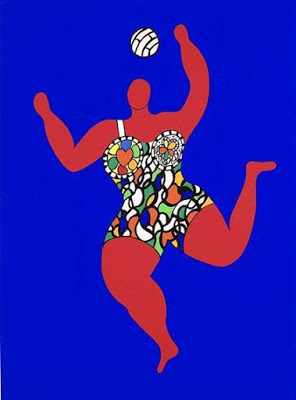by Nina
 |
| Volleyball by Niki de Sainte Phalle |
I recently realized that I think about yoga for healthy aging every single day. This is not just because I’m the Editor in Chief of a blog with that name, it’s because this my life. Many of the decisions I make about what to do each day are because I’d like to stay strong and independent for as long as possible.
Recently I took some walks with a younger woman, who is around 30, and her father, who was in his mid-sixties. During the pandemic the younger woman became discouraged about exercising, and had decided that in addition to working remotely she would just do comforting things, like watching tv. During that same period, her father, on the other hand, had been walking several miles a day, both to and from his office and after work with his wife. Now he was out here visiting his daughter, who he hadn’t seen in months, and on our walks his daughter was having a hard time keeping up with him! We all knew it wasn’t anything serious, and that now that she was more comfortable being outside, she’d regain her strength and endurance stronger quite quickly. But it was a powerful reminder of how quickly you can lose strength and endurance when you don’t exercise regularly. That’s why, along with meditating for thirty minutes a day because it’s something I know will always be there for me, no matter what happens, I continue to practice yoga for healthy aging to maintain my physical skills.
By the way, my idea of independence includes much more than the typical medical professionals focus on, which is just the basic daily self-care activities, such as dressing, going to the toilet, getting up and down from a chair, doing light housework, and so on. I also include the ability to continue to do the activities we love (which I wrote about in my post Being Able to Do What You Love) for as long as possible. While some of these things are activities that we think of as being primarily physical, such as cycling, hiking, doing construction projects, or gardening, they also includes activities that get us out of the house and into the world, such as attending concerts and theatre, art exhibits, and poetry readings, or joining family and other social gatherings. I also think that being independent means being able to continue doing the work that gives shape to our days and allow us to keep our intellects fully engaged, whether that means writing poetry or playing music, keeping up with a law or science career, or teaching in your area of expertise. Finally, I also included the ability to dedicate ourselves to a cause beyond ourselves, whether large, working to solve community or world-wide problems or advocating for a group of oppressed people, or small, such as caring for a family member or even a pet.
Obviously, if basic self-care is all you are physically capable of, you’re going to be missing out on many of these activities. That’s why for a truly independent life, you’ll need a combination of four basic physical skills: strength, flexibility, balance, and agility. And regular asana practice—even one that is modified over time—will help keep you able bodied, rather than sliding into the stiffness and weakness that results from a sedentary lifestyle (see A Declaration of Independence).
Although we’ve written a lot on the blog about the four essential skills individually, I thought today would be a good time to provide an overview of all four, with some links to posts where you can find more information.
Strength. You need physical strength simply to get out of bed, stand well and move about your home, community, or workspace in easy fashion and to carry what you need to take along with you. Even more strength is needed for more demanding physical practices, such as participating in athletic activities. You can use your asana practice to cultivate upper strength, lower body strength, core strength, and bone strength. Maintaining strength also helps you stay healthy, as maintaining muscle strength helps combat sarcopenia and promotes joint health, and maintaining bone strength helps combat osteopenia and osteoporosis. See Yoga for Healthy Aging Strength Sequences.
Flexibility. You need flexibility to maintain range of motion in your joints, allowing you to move your limbs and spine with ease so you can reach or twist as needed. Being flexible also helps you move smoothly and gracefully, rather than stiffly and awkwardly, allowing you to feel more confident in your body. Maintaining flexibility also helps you stay healthy, as flexibility preserves the range of motion in the joints, fostering joint health and improving arthritis symptoms. You can use your asana practice to cultivate flexibility in both your upper and lower body. See Yoga for Flexibility: An Overview for information for now. I’ll be writing a guide to our flexibility sequences soon.
Balance. The ability to balance is crucial for preventing falls, a serious concern for older people. It also allows you to move easily over uneven surfaces, whether that’s a cobblestone street or a mountain path, and to walk up stairs. You can use your asana practice to cultivate several different aspects of balance, from increasing proprioception (your awareness of where your body is in space) to improving your ability to focus. See Yoga for Improving Balance: The Big Picture.
Agility. Maintaining agility increases your reaction time in the real world, preventing injuries and allowing you to participate in activities that require coordination and speed. Even something as simple as walking along a crowded city sidewalk (have you ever walked through the streets of New York on a weekday?) requires significant agility, not to mention dodging rude drivers. And, of course, skillful activities like dancing require even higher levels of agility. Moving in and out of your poses with your breath, linking poses together into simple or complex vinyasasa, and working on transitions into and out of static poses all help foster agility. See New Thoughts About Agility and Yoga for now. I’ll be writing a guide to our agility sequences soon.
Follow Yoga for Healthy Aging on Facebook ° To order Yoga for Healthy Aging: A Guide to Lifelong Well-Being, go to Amazon, Shambhala, Indie Bound or your local bookstore.


Leave A Comment